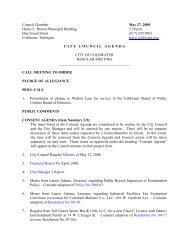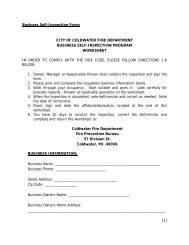Landlord Tenant Guide - State of Michigan
Landlord Tenant Guide - State of Michigan
Landlord Tenant Guide - State of Michigan
- No tags were found...
Create successful ePaper yourself
Turn your PDF publications into a flip-book with our unique Google optimized e-Paper software.
The tenant MUST provide his or herforwarding address—in writing—to thelandlord within 4 days <strong>of</strong> moving out. Callingor telling the landlord, or landlord’s agent,won’t do. While the landlord must inform atenant <strong>of</strong> this at the beginning <strong>of</strong> the lease, alltoo <strong>of</strong>ten a tenant forgets to do this when heor she moves out. Without a forwardingaddress, the landlord has no duty to makearrangements for returning the deposit. If theforwarding address is provided within the4 days, the landlord has 30 days from moveout to respond. If the landlord receives the tenant’sforwarding address within 4 days <strong>of</strong> move out,the landlord has 30 days from move out toeither:a) Return the entire amount <strong>of</strong> the depositby check or money order, ORb) Send—by mail—an itemized list <strong>of</strong>damages lawfully assessed against the depositand a check or money order for the remainingbalance <strong>of</strong> the deposit (if any).The itemized list must also contain thefollowing notice: “You must respond to thisnotice by mail within 7 days after receipt <strong>of</strong>same. Otherwise you will forfeit the amountclaimed for damages.” (See example, page 49.) If the tenant disputes any <strong>of</strong> the itemson the itemized list, the tenant MUSTrespond—in detail, by mail—within 7 days <strong>of</strong>his or her receipt <strong>of</strong> that list. “Responding indetail” means giving reasons why the tenantdisputes each item <strong>of</strong> damage and the amountassessed against his or her security deposit,and why he or she should not be responsible.Simply making a blanket statement that thetenant does not agree will not do; the tenantmust address each item on the list individually.The tenant’s detailed response must be sentto the landlord by mail. If the tenant disputes all or part <strong>of</strong> theitemized list <strong>of</strong> damages, the landlord is leftwith two choices:a) Negotiate or mediate an agreement inwriting with the tenant, ORb) Commence an action in court for amoney judgment for damages that he or sheclaimed against the tenant’s security deposit,which the tenant disputes.Remember, the security deposit remainsthe tenant’s property until the landlordperfects a claim to it—either by agreement orby court order. If the landlord and tenantcannot agree and if the landlord goes to court,he or she MUST prove that the tenant isactually responsible for the damages. Either the landlord or the tenant can bethe plaintiff in a security deposit suit.The landlord may file suit within 45 daysfrom termination <strong>of</strong> occupancy. If both thetenant and the landlord have followed thesecurity deposit timeline perfectly and therestill remains a dispute on the amount <strong>of</strong>damages assessed against the tenant’s securitydeposit, the landlord MUST file suit to retainthe deposit. If the landlord does not file suit,he or she may be liable to the tenant fordouble the amount <strong>of</strong> the security depositretained.The tenant may be required to file suit incertain circumstances. The burden <strong>of</strong> filing suitshifts to the tenant if:a) The tenant failed to provide his or herforwarding address in writing within 4 days <strong>of</strong>terminating occupancy, ORb) The tenant failed to respond—by mail—to the itemized list <strong>of</strong> damages within 7 days<strong>of</strong> receiving it, ORc) The landlord failed to return the tenant’sdeposit after receiving the tenant’s responsedisputing the amount assessed against it.





